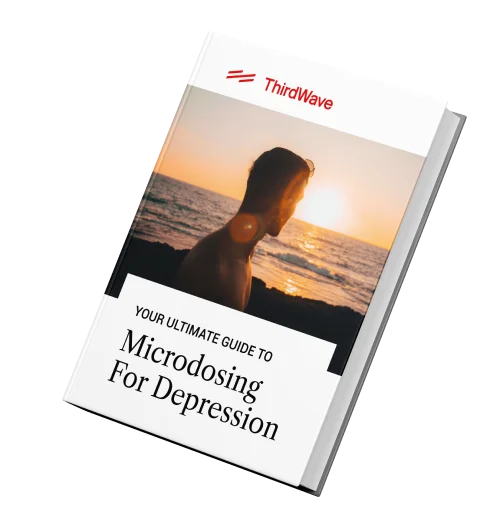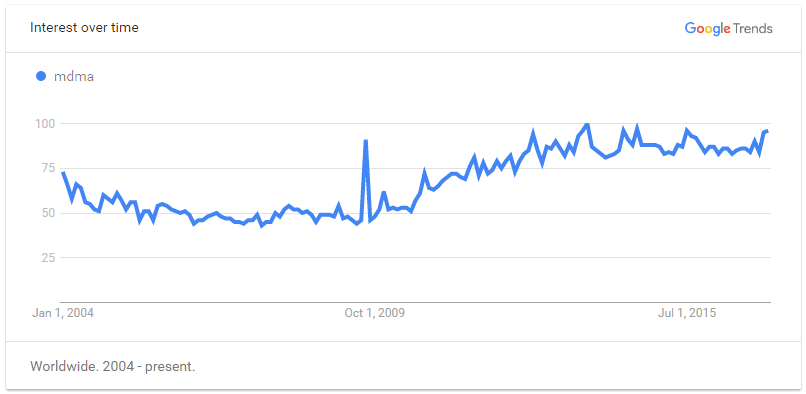The Ultimate Guide to
MDMA
(Ecstasy, E, X, XTC, Rolls, Beans, Adam, Molly)
MDMA is a potentially illegal substance, and we do not encourage or condone the use of this substance where it is against the law. However, we accept that illegal drug use occurs, and believe that offering responsible harm reduction information is imperative to keeping people safe. For that reason, this guide is designed to ensure the safety of those who decide to use the substance.
Overview
01MDMA is a synthetic drug that alters mood and perception, often producing feelings of euphoria, empathy, and emotional well-being. Short for 3,4-methylenedioxy-methamphetamine, MDMA is chemically similar to both stimulants and psychedelics. Under its influence, colors and sounds (especially music) are experienced more intensely, which has made it a popular recreational drug, particularly at raves and music festivals. Though it has a reputation as a club drug, MDMA’s ability to help people gain access to their emotions made it a popular drug to treat depression in the late 1970s, as well as in couples therapy to foster closeness. The psychologist and psychotherapist who first brought MDMA to the world of psychotherapy, Leo Zeff, reportedly called the drug “penicillin for the soul.” But after it became a popular recreational drug, the DEA added MDMA to the list of Schedule 1 drugs in 1985.
In the early 2000s, however, the Multidisciplinary Association for Psychedelic Studies (MAPS) launched the first clinical study into MDMA’s therapeutic potential, specifically for PTSD. In one study, 68% of the 107 participants involved no longer had PTSD one year after treatment. Now, pure crystal MDMA (the only form of the drug that may be legally administered by a medical professional) is in Phase III clinical trials for use as a therapeutic aid in the treatment of PTSD and has been granted “Breakthrough Therapy” status by the FDA. MDMA is on track for full FDA approval and could be prescribed by doctors as early as 2022.
MDMA also has the potential to alleviate social anxiety and save struggling relationships.
MDMA can be deadly at high doses and when combined with other drugs, especially PMA/PMMA.
Sometimes hope comes in micro-doses. This guide will walk you through the process and how to best use the healing potential of psychedelics in a safe, intentional way to heal depression. Sometimes hope comes in micro-doses. This guide will walk you through the process and how to best use the healing potential of psychedelics in a safe, intentional way to heal depression. Get Your FREE Ultimate Guide To Microdosing for Depression.
Get Your FREE Ultimate Guide To Microdosing for Depression.
Experience
02Many factors contribute to the MDMA experience, including dose, mindset, and setting. While there’s no way to predict exactly what will happen, following the Six S’s can help ensure you’ll have a positive experience with minimal negative effects.
What to expect
For most clinical trials, researchers administer doses between 80 and 150mg of MDMA. At this dose level, the onset of effects occurs approximately 20 to 60 minutes after taking the drug, and the characteristic effects (euphoria, increased empathy, and energy, enhanced sensations) typically last for three to five hours.
The high is usually characterized by a relaxed, euphoric state, including emotional openness, reduction of negative thoughts, and a decrease in inhibitions. MDMA can make users feel like all is well in the world, and connecting with others becomes easy. Bodily sensations and touch become enhanced, and sounds and colors can appear more intense.
These effects themselves could be important to the drug’s healing potential by offering users greater access to their inner selves. But researchers also believe that the openness MDMA fosters could speed up the bond between patient and therapist, creating a setting conducive to healing.
Pure MDMA
Your experience will also be affected by the quality of the MDMA you ingest. MDMA purity is notoriously variable, especially in tablet form. In the US, for instance, the average MDMA concentration in ecstasy tablets is reported to be 30.13%.[1] But this includes samples as low as 0% and as high as 100%. Also, while the sample size varies (from 1 to 1,000 pills), individual state averages can be double or half the national average.
Still, this is an improvement: In 2008, police seizures of the chemical precursor safrole meant that, for years, street MDMA concentration in pills was often zero.[2] Since then, the percentage of dud pills (tablets containing no MDMA) has been falling. Meanwhile, the percentage of ecstasy pills containing MDMA alone, without any adulterants, has been climbing. In 2009, 60.1% of ecstasy tablets worldwide contained no MDMA, whereas just 8.7% contained MDMA alone. By 2018, the situation was reversed: 8.8% of ecstasy tablets contained no MDMA, while 54.8% contained MDMA alone.[3]
Part of this has to do with new manufacturing methods. Underground chemists now synthesize the drug with a less heavily restricted precursor. But it also has to do with the darknet, where vendor ratings and competition drive the quality up.[4]
Far from the time when there was too little MDMA in pills, nowadays there’s often too much. Super-strength ecstasy tablets have made headlines in recent years for killing unsuspecting users. Where the MDMA content in ecstasy pills is traditionally between 80 and 120mg, some have been found to contain upwards of 300mg.[5] A high-end dose like this can be dangerous enough in itself, let alone when you’re not expecting it.
Reagent test kits from Bunk Police in addition to the services provided by EcstasyData.org and Pill Reports are excellent resources for gauging pill safety. Short of testing the drug before consuming it, the safest way to use ecstasy pills is to start with half a tablet and gauge how you feel after an hour.[6][7]
Effects
03Pharmacology
MDMA affects the brain by increasing the activity levels of three neurotransmitters: dopamine, norepinephrine (noradrenaline), and serotonin. [8]
Increases in dopamine are what create MDMA’s euphoric effects, as well as the increased energy users feel. Increases in norepinephrine/noradrenaline cause increased heart rate and blood pressure while increases in the serotonin system cause changes in mood, appetite, sexual arousal, and sleep cycles. Spikes in serotonin after taking MDMA likely account for the common feelings of emotional closeness and empathy.
Toxicology
Potentially fatal neurological complications can occur following MDMA ingestion, likely due to short-term hypertension and dehydration that the drug induces.
Many fatal cases are due to abnormally high doses, prior health complications, a “bad batch,” or a combination of all of these. In fatal cases, necrosis of the liver and heart tissue have also been reported.[9] It’s often difficult to tell exactly how much of a role MDMA plays in adverse reactions because, in these cases, people are more likely to have used multiple drugs.[10] As with any substance, MDMA should be used in moderation. Frequent use correlates with more complications than occasional use.[11]
Clinical studies with pure MDMA have been conducted on more than 1,100 individuals without the occurrence of severe adverse effects.[12]
Effects By Dose
NOTE: Effects listed here aren’t meant to be comprehensive, particularly at the lower dose ranges. They may be subject to change as more reliable, more widely representative data become available. These dose ranges are intentionally conservative to account for the high variability of MDMA purity. They assume 100% (aka 84%) purity.
Listen to our podcast with Charley Wininger to find out Why MDMA is the Chemical of Connection or Click here to read the transcript
Microdose (5-40 mg)
Microdosing MDMA is not as common as LSD and psilocybin, but with the general rise in interest in microdosing, some have wondered if the practice could enhance their moods and boost their energy. While some people have reported success with an MDMA regimen, we do not recommend it. There is a lot of evidence to suggest that frequent MDMA use can be very bad for you. After all, MDMA is not like classic psychedelics; it’s an amphetamine and a stimulant that does very different things to your body than a tab of LSD. Common effects may include:
- Slight mood enhancement, if at all
- Emotional vulnerability (opened to emotional content without anxiolytic effect)
- Disrupted sleep
- Extended comedown or hangover
- Mood disorders can be negatively effected
- Potential for heart issues
Moderate (80-150 mg)
This is the most common dose for an MDMA experience and the dose used in clinical trials. In this range, users report the typical MDMA-associated sensations: euphoria, increased energy, empathy, etc. In this range, many people practice “re-upping,” which involves taking an initial 80-120mg dose, followed by an additional 40-80mg later on. This is the practice for MAPS’ clinical trials. Common effects may include:
- Strong euphoria
- Therapeutic introspection
- Heightened self-esteem
- Openness and self-forgiveness
- Heightened empathy and sociability
- Increased energy
- Enhanced tactile, visual and auditory senses
- Dry mouth
- Jaw clenching/grinding
- Insomnia
- Possible next-day comedown effects, e.g. fatigue, depression (can also be felt over the next seven days)
Heavy (200+ mg)
Even with tolerance, it may be unsafe to take more than 120mg of high-purity MDMA (or 1.5-1.7 mg/kg body weight, whichever is lowest). Positive effects appear to be maximized and negative effects are minimized between 81-100mg, ideally taken no more than once a month. Heavy doses of high-purity MDMA are potentially life-threatening, regardless of tolerance.
- Strong euphoria
- Therapeutic introspection
- Heightened self-esteem
- Openness and self-forgiveness
- Heightened empathy and sociability
- Increased energy
- Enhanced tactile, visual and auditory senses
- Possible open-eye visuals or hallucinations
- Agitation and paranoia
- Panic
- Dizziness
- Headaches
- Nausea and vomiting
- Shivering/trembling
- Dehydration
- Jaw clenching/grinding
- Insomnia
- Seizure
- Next-day comedown effects, e.g. fatigue, depression (can also be felt over the next seven days)
Interactions With Other Drugs
Positive interactions:
- Mushrooms: Known as “hippie flipping,” mixing psilocybin with MDMA is a popular combination. While mixing MDMA with any drug is not generally not recommended, this combination can be enjoyable and enhance aspects of both substances, particularly euphoria. The downside is that if the timing is off, the MDMA comedown could alter your mood for the last hours of your mushroom journey.
- LSD: Much like with psilocybin, combining LSD and MDMA (known as “candy flipping”) has its pros and its cons. With the MDMA can turn up the volume on the more psychedelic aspects of LSD, the comedown of this combination can be even more challenging than with mushrooms. It’s key to get the timing of the ingestion right.
- Ketamine: Another common combination, many users of the “kitty flip” also say that it brings out the best of both drugs.
Neutral interactions:
- Cannabis: Many people use cannabis to mitigate the comedown effects of MDMA. This may be one of the least risky combinations.
Negative interactions:
- Alcohol: Because the liver metabolizes both drugs, combining the two can cause a buildup of MDMA in the body—metabolizing alcohol slows the removal of MDMA from the body. This can lead to stronger adverse reactions and more serious side effects.
- Drugs to be avoided include:
- MAOIs (e.g. Nardil, Parnate, Marplan, Ayahuasca)
- 5-HTP
- St. John’s wort
- Heart rate or blood pressure medications
- Stimulants such as cocaine
- Amphetamines
In Third Wave’s Ultimate Guide to Safely Sourcing Psychedelics, you will discover an astonishing menu of psychedelic medicines… In Third Wave’s Ultimate Guide to Safely Sourcing Psychedelics, you will discover an astonishing menu of psychedelic medicines… Beyond LSD and Psilocybin is a field. This guide will take you there.
…and how to source them without legal risk. Beyond LSD and Psilocybin is a field. This guide will take you there.
…and how to source them without legal risk.
Benefits & Risks
04Potential Benefits
While MDMA is known for giving rise to feelings of euphoria and general well-being, the benefits of the drug extend beyond several hours of bliss—it holds the potential to heal trauma, anxiety, disconnection, and possibly more. A recent study that looked at MDMA’s effects on the brain found that this healing could come from the drug’s ability to decrease activity in the brain’s limbic system and reduce communication between the temporal lobe and prefrontal cortex, both of which are involved in emotional control and response. People with anxiety see an increase in activity in these areas, suggesting that MDMA can help alleviate related mood disorders.
MDMA also increases communication between the amygdala and the hippocampus, according to the study. People suffering from PTSD, on the other hand, see a reduction in communication between these areas.
Another recent study by Dr. Ben Sessa found that MDMA could also be the best intervention to treat acute childhood trauma by offering people safe access to their emotions. “In combination with psychotherapy, [MDMA] provides the capacity to hold the traumatized patient in a state of emotional security, providing a state of empathic self-reflection,” Sessa writes, adding that, “for the first time in their lives, they can be with their traumatic memories without being overwhelmed by the powerful negative effect that usually accompanies recall of their most frightening thoughts.” This empathic self-reflection is also one of the reasons MDMA is proving to be such an effective treatment for PTSD.
MDMA is also known for fostering a greater sense of connection and empathy in users, making it a strong antidote to feelings of distance and disconnectedness, particularly between couples. Relationship therapists are starting to use the drug in their sessions to help couples enhance communication, heighten intimacy, and reconnect. It’s not called “the love drug” for nothing.
Risks
Adverse physiological effects can occur after ingesting MDMA, including elevated blood pressure and heart rate, nausea, chills, sweating, tremors, jaw clenching, hyperreflexia, urinary urgency, muscle aches or tension, hot and cold flushes, nystagmus (a condition in which the eyes make repetitive, uncontrolled movements), and insomnia. At higher doses, these physiological changes can result in severe adverse reactions.
MDMA overdoses can and do kill. A high dose can be a contributing factor in deadly conditions such as hyperthermia, exhaustion, or hyperhydration. Additionally, it can trigger serotonin syndrome, or too much serotonin, which can cause muscle rigidity, fever, seizures, and more.
Some people report an unpleasant comedown including feelings of depression and fatigue after a night of heavy MDMA use. In our microdosing course, Dr. Ben Sessa explains how the typical MDMA comedown is due to overexertion, poor sleep, poor diet, and polydrug use. As such, the comedown can be countered by eating and sleeping well before and after taking MDMA, keeping hydrated if you’re dancing, and avoiding other substances (including alcohol).
Recent research also shows that patients in clinical trials tend to experience an MDMA “afterglow” rather than a comedown, suggesting that pure MDMA alone does not produce these effects. Most adverse side effects can be attributed to adulterated MDMA, or “ecstasy,” which is often mixed with ephedrine, dextromethorphan, bath salts, cocaine, or methamphetamine. 87% of the ecstasy analyzed by the DEA between 2009 and 2013 contained no MDMA and was composed mostly of bath salts.
MDMA itself is not addictive, but due to the highly addictive nature of methamphetamines, some people may become addicted to impure forms of MDMA.
A caution on PMA/PMMA (aka ‘Death’)
The prohibition of MDMA in most countries (and especially the police seizures of safrole in 2008/2010 interrupting the supply of ecstasy) has led to the emergence of certain alternatives. These substances, about which we know relatively little, tend to be far more dangerous than MDMA itself. And yet they’re legal by default in many jurisdictions.
Following the procedure for making MDMA with aniseed oil instead of safrole, for example, yields not ecstasy but the problematic substances para-Methoxyamphetamine (PMA) or para-Methoxy-N-methylamphetamine (PMMA).[13] Both have been implicated in the deaths of unsuspecting users from as early as 1993.[14] In December 2014/January 2015, for instance, at least three individuals died after taking the same pink “Superman” pills containing PMA.[15][13]
PMA/PMMA can be 10 to 20 times more potent than MDMA, putting users taking a “safe” dose of what they believe to be ecstasy at risk of massively overdosing on a far more dangerous substance. [15][13] PMA/PMMA are also slower-acting, which means experienced ecstasy users are likely to re-dose too soon.
The trouble is, PMA/PMMA are not MDMA analogs. They have a different pharmacological action. Unlike MDMA, they block certain enzymes (e.g. monoamine oxidase, or MAO) that offset the release of serotonin. As a result, they can lead to serotonin syndrome, a potentially deadly overload of the body’s serotonin levels.[13][14] While reagent testing can help to identify the presence of PMA/PMMA, the presence of real MDMA could disguise the presence of PMA/PMMA as adulterants. Checking pills against user reports online (such as EcstasyData.org and Pill Reports) is therefore a sensible precaution.
Therapeutic Use
05PTSD
In 2017, MDMA was approved for use in Phase III clinical trials in the US to treat post-traumatic stress disorder (PTSD). [16][17] This is one of the last phases of testing before a drug is legally approved for therapeutic use. The FDA granted MDMA “breakthrough therapy” status in 2017 and the drug is on the path to full FDA approval.
The trials are being funded by MAPS, which began studying and advocating for the use of MDMA to treat PTSD in 1986. Though the organization supports other psychedelic therapies, including LSD and psilocybin, they chose to focus on MDMA based on the fact that it is “the gentlest psychedelic,” according to MAPS founder Rick Doblin, as well as “the perfect drug for treating PTSD.”
Research is backing this up. In a pilot study conducted by MAPS involving 20 patients with PTSD, the placebo group showed only a 25% response rate to the therapy (2 of 8 patients). Meanwhile, the MDMA group had an 83% response rate (10 of 12 patients). Following the treatment, nearly all of those who had received MDMA before psychotherapy no longer met PTSD criteria. The study also found no evidence of harm to patient health from a single session. Perhaps most remarkably, a long-term follow-up study found that 74% of the patients who had relieved their PTSD symptoms in the first study remained PTSD-free years later.
In a later Phase II trial, researchers found that 54% of the 72 patients who underwent MDMA-assisted psychotherapy no longer fit qualified as having PTSD (compared with 23% in the control group). A year later, that number had risen to 68%.
There are many theories around why MDMA is proving to be such a strong antidote to PTSD. According to Doblin, there are two main reasons: MDMA reduces fear (PTSD stems from fear) and it promotes therapeutic alliance, or the relationship between patient and therapist, which is one of the most important factors in a patient’s recovery. Additionally, MDMA activates and quiets key parts of the brain associated with reductions in anxiety, depression, and trauma.
Listen to our podcast episode with Ingmar Gorman talking about: Why Microdosing Requires A Cautious Approach or Click here to read the transcript
Many patients who undergo this therapy are war veterans with a treatment-resistant form of PTSD. They report that MDMA therapy helped them approach their past trauma with a greater sense of acceptance, warmth, and compassion for themselves, allowing them greater opportunity to cope and heal.
Read more about the use of MDMA in the treatment of PTSD.
Anxiety
Preliminary results from a few studies suggest MDMA is also a promising treatment for social anxiety in individuals with autism and life-threatening illnesses.[18] In the first clinical trial investigating MDMA for people with autism, 12 individuals were given MDMA or a placebo during two all-day therapy sessions. Among those who took the drug, 91% of participants reported “increased feelings of empathy/connectedness” and 86% experienced “ease of communication” during their sessions, which persisted after use.
It’s thought that this success is due to MDMA’s ability to shift patients with social anxiety toward openness and encourage introspection, which can be accomplished with infrequent or even single doses of MDMA.
This same mechanism also appears to operate in treating patients with life-threatening illnesses who experience clinical anxiety.[19] MAPS is currently conducting a Phase II trial to explore this area of MDMA’s potential.
Alcohol Use Disorder
In 2017, Ben Sessa launched the first clinical trial examining the efficacy of MDMA in treating alcohol addiction. An illness often associated with early traumatic experiences, Sessa believes that MDMA is ideal for helping patients explore and address painful memories without being overwhelmed by negative reactions—much the way MDMA works for PTSD. “We know that MDMA works really well in helping people who have suffered trauma and it helps to build empathy,” Sessa said. “Many of my patients who are alcoholics have suffered some sort of trauma in their past and this plays a role in their addiction.”
Are you feeling drawn to work with plant medicines? Third Wave’s vetted Psychedelic Directory offers an honest, in-depth guide to safely accessing these substances.
Personal Growth
06Spiritual Awareness
Though a connection to the spiritual realm is more often associated with classic psychedelics such as LSD and psilocybin, for many, MDMA is also a tool for spiritual growth. Some spiritual leaders and guides laud the drug’s ability to induce feelings of oneness, interconnectedness, empathy, compassion, warmth, and kindness toward others. States such as these are often catalysts for spiritual epiphanies and personal development.
As the Benedictine monk Brother Bartholemew put it:
“MDMA always propels me into an intimate space in conversation. There is a special quality to this conversation. One feels a heaviness, a sense of the weight of the moment, of something profound, of the seriousness of life itself. It is a space that is inner, without masks, without pretense, utterly open and honest. It is not an erotic intimacy, but a philosophical and mystical intimacy. Does this make any sense? One has the consciousness that this is an inner communication rarely achieved in ordinary discourse. There really are no adequate words to express this state of awareness, only to say, that it is essential in my experience.”
MDMA can be used in many sets and settings to invoke spiritual development, from quiet introspection to meditation in groups to therapy. Even rolling at raves can have a spiritual quality if approached with the right intention.
Relationships
MDMA is also proving to be a useful tool for building or repairing relationships. Relationship therapists are beginning to use the drug in their sessions to help couples enhance communication, heighten intimacy, and reconnect. Its use in relationship work dates back to the 1970s when a group of unorthodox therapists inspired by the work of psychopharmacologist and MDMA advocate Alexander Shulgin used MDMA to help partners foster empathy and communication. The practice is gaining popularity again due to the MDMA’s ability to “facilitate the psychotherapeutic process by helping people feel safer and more connected to themselves, to each other, and to their therapist,” according to MAPS’ Brad Burge.
Katie Anderson, a British doctoral researcher who is completing a Ph.D. on the topic of “navigating intimacy with ecstasy,” has deemed this increased connection between two people the “MDMA bubble.” In it, couples find a safe space to have their thoughts heard and accepted. Her research has seen couples expressing sexual fantasies, the pain of losing a parent or even confessing to affairs. As one respondent put it: “I think we keep ourselves protected, we don’t want to get hurt. But when you’re taking the drug, it allows you to take down those walls and just be open to somebody.”
Legality
07
History & Stats
08Brief history
MDMA’s history began decades before the rave culture that popularized it. A common myth is that it was first synthesized and patented by the German pharmaceutical company Merck as an appetite suppressant. Merck did synthesize the drug in 1912, but the appetite suppressant story is an urban legend. It was developed as a potentially life-saving blood-clotting medicine.
Minimal testing was done in the early years after its synthesis. It was not until 1927 that Merck revived interest in the drug after chemist Max Oberlin predicted that it might mimic adrenaline since the chemicals shared a similar molecular structure. Not long after these initial studies began, the prices of chemical precursors skyrocketed, and testing was put on hold.
While no one knows precisely when the first human trials were conducted, the US military is known to have tested MDMA and other drugs on humans in the 1950s. The first “recipe” for MDMA was published in a Polish-language scientific journal in 1960 and tablets began popping up in seized contraband in the 1970s.
When American psychopharmacologist Alexander Shulgin first read about MDMA in 1978, he synthesized it and tried it himself, becoming the first person to officially record MDMA use in a human subject.[24] In the 1980s, its use in assisted psychotherapy was said to increase patient self-esteem and facilitate therapeutic communication.[25]
While Shulgin is often called “the Godfather of Ecstasy,” MDMA’s actual creator was a German scientist named Anton Kollisch, who died in 1916 never knowing the legacy he left.
Since 1985, the drug has been listed as a Schedule I drug in the US, making it effectively illegal for all uses. However, clinical trials have been approved and conducted in recent years, and in 2017, the FDA granted MDMA “breakthrough therapy” status. It’s thought that the doctors could be prescribing the drug as early as 2022.
In 2011, a federal court sided with the ACLU, which argued that punishments for MDMA possession and use were based on outdated science that led to severe prison sentences[26]. However, other courts have upheld the previous sentencing laws.
Current use
The annual National Survey on Drug Use and Health found that MDMA had been used at least once by 13.1% of people between the ages of 18 and 25, and 6.5% of people age 26 and over.
| Time Period | Ages 12 or Older | Ages 12 to 17 | Ages 18 to 25 | Ages 26 or Older |
| Lifetime | 6.80% | 1.40% | 13.10% | 6.50 |
| Past Year | 1.00% | 0.80% | 4.10% | 0.50 |
| Past Month | 0.20% | 0.10% | 0.90% | 0.10% |
These trends appear to be holding relatively steady:
| 18 to 25-Year-Olds | 26 Years Old and Over | |||||
| Time Period | 2013 | 2014 | 2015 | 2013 | 2014 | 2015 |
| Lifetime | 12.80 | 12.00 | 13.10 | 6.40 | 6.40 | 6.50 |
| Past Year | 4.00 | 3.50 | 4.10 | 0.50 | 0.50 | 0.50 |
| Past Month | 0.90 | 0.80 | 0.90 | 0.10 | 0.10 | 0.10 |
Its appearance in published reports and literature reached a peak in the early- to mid- 2000s and has fallen quite a bit since then:
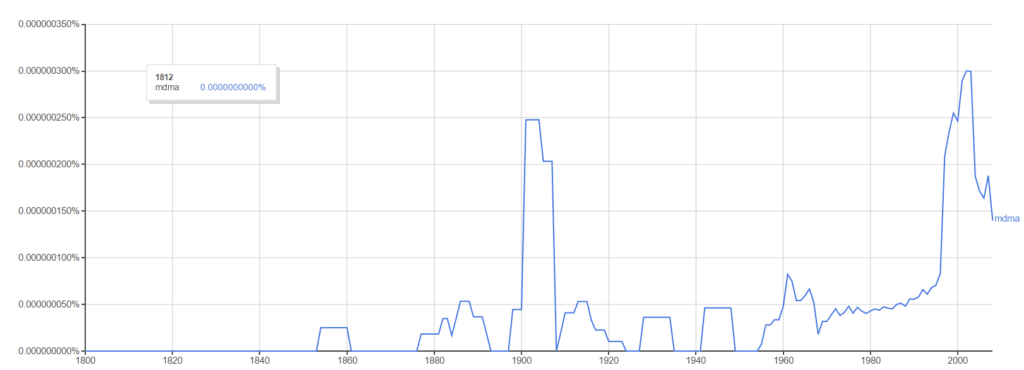
Sometimes hope comes in micro-doses. This guide will walk you through the process and how to best use the healing potential of psychedelics in a safe, intentional way to heal depression. Sometimes hope comes in micro-doses. This guide will walk you through the process and how to best use the healing potential of psychedelics in a safe, intentional way to heal depression. Get Your FREE Ultimate Guide To Microdosing for Depression.
Get Your FREE Ultimate Guide To Microdosing for Depression.
Myths
09“Ecstasy will make me drink so much water that I’ll die”
Although one infamous ecstasy-related death was caused by overhydration, MDMA itself will not make you drink yourself to death. The victim in this case thought that by drinking a large amount of water, she would counteract an unpleasant ecstasy experience. Unfortunately, because MDMA also makes it harder for the body to process water, she died from water retention.
This doesn’t mean you should avoid drinking water when you’re on MDMA. Taking a very high dose can cause an inability to regulate your hydration, so you should make sure you’re drinking water regularly – especially if you’re dancing or exerting yourself.
The main cause of MDMA-related deaths is a lack of education. People don’t know how to take the drug safely and end up increasing their health risks. When used responsibly, it is a relatively safe drug.
“MDMA is a club drug only”
Although MDMA is very popular for use in clubs due to its enhancement of music and dance, that doesn’t mean it’s exclusively a clubber’s drug. Many people take it in a spiritual or therapeutic context. It can be used for various forms of personal and relationship development, and clinical trials are using it to treat sufferers of post-traumatic stress disorder, anxiety, addiction, and more.
“MDMA puts holes in your brain”
There is no evidence that moderate use (less than 100mg every few weeks) can cause damage to your brain.
Frequent high dose use can cause heart problems and memory problems. Additionally, it’s relatively easy to overdose on MDMA if it’s combined with other drugs, especially PMA/PMMA. MDMA overdose can be lethal.
FAQ
10What is MDMA?
MDMA stands for 3,4-Methylenedioxymethamphetamine. It’s one of the world’s most popular psychedelics (though technically it’s an empathogen). Until recently it was seen as more of a “party drug” than LSD or psilocybin. But it’s currently re-emerging as a breakthrough psychotherapeutic aid.[27] Researchers are especially enthusiastic about its potential for PTSD treatment.
It comes in two basic forms: tablets (or pills), which are often called “ecstasy,” and crystals (or powder), often called “Molly.”
Can I test my MDMA to see if it’s safe to take?
Testing your MDMA is always good practice even when you trust your supplier. Reagent test kits from Bunk Police can identify hundreds of adulterants and substitutes—offering peace of mind and potentially saving your life.
DXM, MDA, methamphetamine, methylone (“bath salts”), and PMA/PMMA are some common imposters to beware of. The Marquis, Mecke, and Simon’s reagents can help to rule them out. Simply place a tiny amount of MDMA into a sterile test tube or onto a sterile white ceramic surface and add a few drops of the reagent. Then check the color change (or lack thereof) against the supplied spectrum booklet.
What type of drug is MDMA?
It is a type of amphetamine, a stimulant class of drugs that includes speed and methamphetamine. But MDMA is considerably more benign. As an amphetamine, it’s also part of the phenethylamine class of substances, like mescaline. Of course, the effects are substantially different. Based on these, MDMA may be classified as an entactogen or euphoric empathogen.
What does MDMA do?
Regardless of dosage, it’s a stimulating drug. Most people report physical and emotional euphoria, along with mild visual effects, such as color enhancement. Increased stamina (e.g. for dancing) is also common.
Side effects include increased perspiration, dehydration, jaw clenching, and involuntary shaking.[28]
How do I take MDMA?
MDMA may be ingested as an oral tablet or in crystal or powdered form, which can be taken orally or insufflated (snorted). Snorting MDMA tends to be unpopular, however, because of the bad flavor, potential for nose bleeds (as well as anxiety and palpitations), and the relatively short-lived effects. Many people mix the crystal into their drinks to avoid the bitter taste. Smoking or vaping is another option, but it’s even less popular than snorting.
Effects will take up to an hour to appear. Don’t redose too frequently. Don’t mix with other drugs.
How long does MDMA last?
The effects last for three to six hours. You should begin to feel them 20 to 90 minutes after dosing. The peak itself may last anywhere between 90 minutes and three hours before diminishing over the following one to two hours.
After the primary effects have worn off, you may experience a “comedown” or post-trip “crash” characterized by feelings of depression and fatigue. These can be mild or severe and may last between 12-72 hours, or possibly up to a week.[28][29]
What about the purity of crystal/powder MDMA?
Despite what you may have been sold, even in crystal or powder form, pure MDMA is difficult to find on the street. However, as previously noted, street MDMA concentration has been climbing in recent years. In the UK, at least, it has apparently reached 83%.[30] This is pretty much the maximum purity that’s available.[31]
MDMA in pure form has by definition a purity of 100%. Unfortunately, whatever form it’s in, a sample is unlikely to be pure. There’s probably something else in it—and adulterants can be deadly. Using a test kit is a good precaution. These can identify the presence of MDMA as well as toxic adulterants by a color change you can check on a chart. However, chemical reagent tests cannot tell you the purity; they’re only indicative at best. They should, therefore, be used alongside other harm reduction practices.[32]
How long does MDMA stay in your system?
Like other amphetamines, it stays in the system for 24-96 hours after use, with 72 hours being the average.[33]
Can it be detected in a drug test?
MDMA is structurally close enough to amphetamines to return a positive result in standard urine drug screens up to five days after use. It is also detectable in hair samples for up to 90 days.[33]
Does it produce tolerance?
MDMA depletes serotonin levels, so users often experience a “hangover” lasting up to a few days, during which they may feel depressed or mentally exhausted. Therefore, expect an MDMA tolerance to last for several days.
It’s best to avoid taking MDMA more than once a month, as long-term use can be neurotoxic and affect memory and mood.
Is it addictive?
According to the National Institute on Drug Abuse, studies have so far failed to definitively answer this question.[34] However, most people who actually use MDMA find it to be non-addictive.[35]
Can I mix it with other drugs?
MDMA should not be mixed with other drugs, as some combinations can be dangerous. Since it affects the kidneys and liver, it’s best to avoid combining it with alcohol. You should also avoid mixing it with DXM, tramadol, and MAOIs, as these combinations can be fatal.
The best way to take MDMA is without any other drug, and with plenty of water if you’re dancing. This should help to minimize health risks.
Can I microdose with MDMA?
Some people have reported microdosing MDMA, but it’s possible that long-term use can be toxic. It depletes serotonin levels, and microdosing could leave you with a long hangover. MDMA should be used once a month at most to avoid any dangers of long-term neurotoxicity.
Here’s more information about the dangers of microdosing MDMA.
Footnotes
11[1] Blackford, M. (2017, Nov 29). Red, White, and Blue Pills. Retrieved from https://fherehab.com/news/red-white-blue-pills/.
[2] Shapiro, H., Daly, M. (2017). Highways and buyways: A snapshot of UK drug scenes 2016. London: DrugWise. Retrieved from http://www.drugwise.org.uk/wp-content/uploads/Highwaysandbyways.pdf.
[3] EcstasyData.org. (2019). Test Result Statistics: Summary Data. Retrieved from https://www.ecstasydata.org/stats.php.
[4] Daly, M. (2015, Apr 1). UK: This Is What’s Actually in Your Ecstasy. Retrieved from https://www.vice.com/en_uk/article/nnq88q/uk-this-is-whats-actually-in-your-ecstasy-394.
[5] EcstasyData.org. (2019). Results: Lab Test Results for Recreational Drugs. Retrieved from http://ecstasydata.org/results.php?high_dose_mdma=1.
[6] The Loop. Club Drug Info. Retrieved from https://wearetheloop.org/club-drug-info/.
[7] Erowid. (2016, Oct 7). Erowid MDMA Vault : Dosage. Retrieved from https://erowid.org/chemicals/mdma/mdma_dose.shtml.
[8] NIDA. MDMA (Ecstasy/Molly). Retrieved from https://www.drugabuse.gov/drugs-abuse/mdma-ecstasymolly.
[9] Green, A. R., Mechan, A. O., Elliott, J. M., O’Shea, E., & Colado, M. I. (2003). The pharmacology and clinical pharmacology of 3, 4-methylenedioxymethamphetamine (MDMA, “ecstasy”). Pharmacological Reviews, 55(3), 463–508.
[10] Gouzoulis-Mayfrank, E., & Daumann, J. (2006). The confounding problem of polydrug use in recreational ecstasy/MDMA users: a brief overview. Journal of Psychopharmacology, 20(2), 188–193.
[11] Parrott, A. C., Sisk, E., & Turner, J. J. D. (2000). Psychobiological problems in heavy “ecstasy”(MDMA) polydrug users. Drug and Alcohol Dependence, 60(1), 105–110.
[12] Danforth, A. L., Struble, C. M., Yazar-Klosinski, B., & Grob, C. S. (2016). MDMA-assisted therapy: a new treatment model for social anxiety in autistic adults. Progress in Neuro-Psychopharmacology and Biological Psychiatry, 64, 237–249.
[13] Nutt, D. (2015, Jan 5). The Superman pill deaths are the result of our illogical drugs policy. Retrieved from https://www.theguardian.com/commentisfree/2015/jan/05/superman-pill-ecstasy-pma-deaths-drugs-policy.
[14] EMCDDA. (2003). Report on the risk assessment of PMMA in the framework of the joint action on new synthetic drugs. Retrieved from https://erowid.org/chemicals/pmma/pmma_article1.pdf.
[15] Caitlin. (2015, Jan 23). UK PMA Deaths: The case for drug testing and a push for drug policy reform. Retrieved from https://www.release.org.uk/blog/uk-pma-deaths-case-drug-testing-and-push-drug-policy-reform.
[16] Mukherjee, S. (2016, Nov 30). Ecstasy Could Soon Double as a Prescription Drug for PTSD Patients. Retrieved from http://fortune.com/2016/11/30/fda-mdma-approval/.
[17] Philipps, D. (2016, Nov 29). F.D.A. Agrees to New Trials for Ecstasy as Relief for PTSD Patients. Retrieved from https://www.nytimes.com/2016/11/29/us/ptsd-mdma-ecstasy.html.
[18] Danforth, A. L., Struble, C. M., Yazar-Klosinski, B., & Grob, C. S. (2016). MDMA-assisted therapy: a new treatment model for social anxiety in autistic adults. Progress in Neuro-Psychopharmacology and Biological Psychiatry, 64, 237–249.
[19] Mithoefer, M. C., Grob, C. S., & Brewerton, T. D. (2016). Novel psychopharmacological therapies for psychiatric disorders: psilocybin and MDMA. The Lancet Psychiatry, 3(5), 481–488.
[20] Erowid. (2016, Jun 8). Erowid MDMA Vault : Legal Status (Ecstasy). Retrieved from https://erowid.org/chemicals/mdma/mdma_law.shtml.
[21] Sheikh, K. (2016, Nov 30). MDMA could be on the market legally by 2021. Retrieved from https://www.popsci.com/fda-just-approved-final-stage-mdma-drug-trials.
[22] GOV.UK. Drugs penalties. Retrieved from https://www.gov.uk/penalties-drug-possession-dealing.
[23] Ministerio de Justicia y Derechos Humanos. (2016, May). Decreto Legislativo No 635: Código Penal. Retrieved from http://spij.minjus.gob.pe/content/publicaciones_oficiales/img/CODIGOPENAL.pdf.
[24] Shulgin, A. T., & Nichols, D. E. (1978). Characterization of three new psychotomimetics. The Pharmacology of Hallucinogens. New York: Pergamon.
[25] Green, A. R., Mechan, A. O., Elliott, J. M., O’Shea, E., & Colado, M. I. (2003). The pharmacology and clinical pharmacology of 3, 4-methylenedioxymethamphetamine (MDMA, “ecstasy”). Pharmacological Reviews, 55(3), 463–508.
[26] ACLU. (2011, Jul 15). Court Rejects Harsh Federal Drug Sentencing Guideline as Scientifically Unjustified. Retrieved from https://www.aclu.org/news/court-rejects-harsh-federal-drug-sentencing-guideline-scientifically-unjustified.
[27] MAPS. MDMA-Assisted Psychotherapy. Retrieved from https://maps.org/research/mdma.
[28] PsychonautWiki. (2019, Jan 18). MDMA. Retrieved from https://psychonautwiki.org/wiki/MDMA#Subjective_effects.
[29] Erowid. (2016, Oct 7). Erowid MDMA Vault : Effects. Retrieved from https://www.erowid.org/chemicals/mdma/mdma_effects.shtml.
[30] Mixmag Staff. (2015, Jun 22). Drug welfare groups advise MDMA users to ‘crush-dab-wait’. Retrieved from https://mixmag.net/read/drug-welfare-groups-advise-mdma-users-to-crush-dab-wait-news/.
[31] Erowid Crew Blog. (2017, Jan 19). Technical Oddity: Dutch Testing Service (DIMS) Defines Pure MDMA Crystal as 84% Pure. Retrieved from https://www.erowid.org/columns/crew/2017/01/oddity-testing-service-defines-pure-mdma-as-84-pure/.
[32] Stevens, O. (2017, Feb 22). Recreational MDMA testing – a European perspective. Retrieved from http://www.drugscience.org.uk/blog/2017/2/22/recreational-mdma-testing-a-european-perspective.
[33] Erowid. (2015, Feb 10). Erowid MDMA Vault : Drug Testing. Retrieved from https://erowid.org/chemicals/mdma/mdma_testing.shtml.
[34] NIDA. (2017, Sep). Is MDMA Addictive? Retrieved from https://www.drugabuse.gov/publications/research-reports/mdma-ecstasy-abuse/mdma-addictive.
[35] DanceSafe. (2018, Feb 10). MDMA. Retrieved from https://dancesafe.org/ecstasy/.
Beyond LSD and Psilocybin is a field. This guide will take you there.
In Third Wave’s Ultimate Guide to Safely Sourcing Psychedelics, you will discover an astonishing menu of psychedelic medicines…
…and how to source them without legal risk.
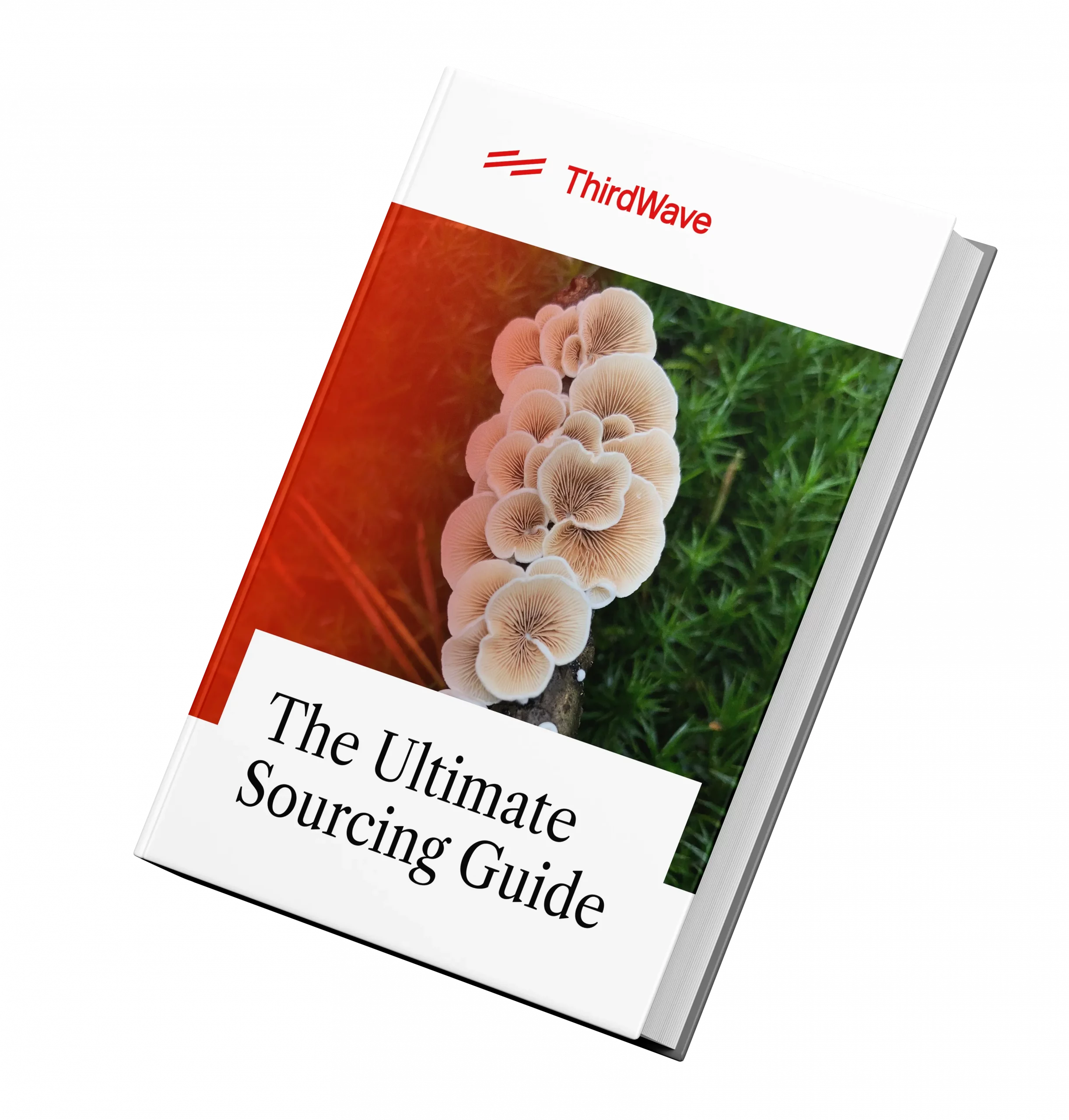
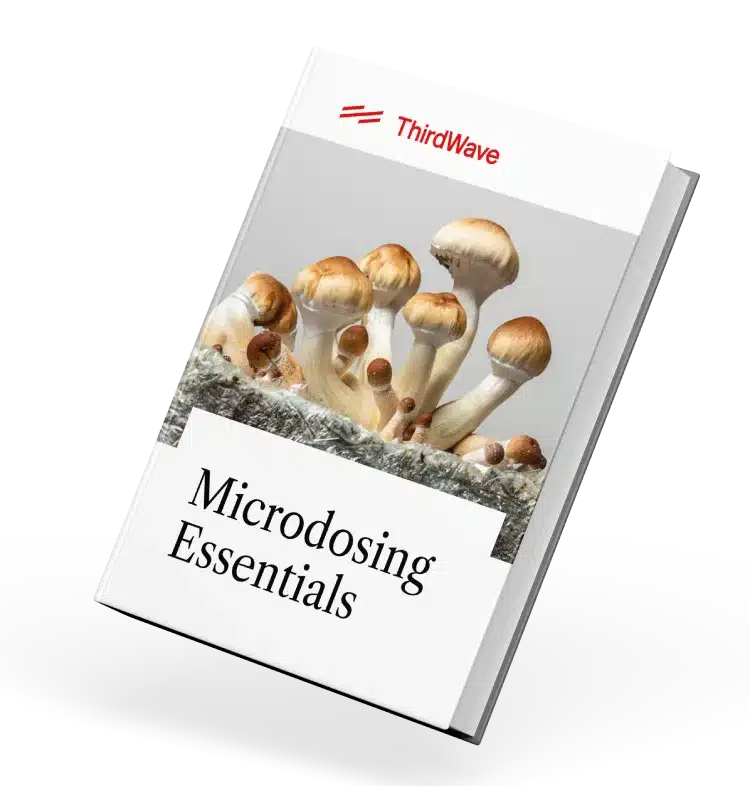
Beyond LSD and Psilocybin is a field. This guide will take you there.
In Third Wave’s Ultimate Guide to Safely Sourcing Psychedelics, you will discover an astonishing menu of psychedelic medicines…
…and how to source them without legal risk.
